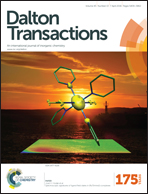From molecular germanates to microporous Ge@C via twin polymerization†
Abstract
Four molecular germanates based on salicyl alcoholates, bis(dimethylammonium) tris[2-(oxidomethyl)phenolate(2-)]germanate (1), bis(dimethylammonium) tris[4-methyl-2-(oxidomethyl)phenolate(2-)]germanate (2), bis(dimethylammonium) tris[4-bromo-2-(oxidomethyl)phenolate(2-)]germanate (3) and dimethylammonium bis[2-tert-butyl-4-methyl-6-(oxidomethyl)phenolate(2-)][2-tert-butyl-4-methyl-6-(hydroxymethyl)phenolate(1-)]germanate (4), were synthesized and characterized including single crystal X-ray diffraction analysis. In the solid state, compounds 1 and 2 exhibit one-dimensional hydrogen bonded networks, whereas compound 4 forms separate ion pairs, which are connected by hydrogen bonds between the dimethylammonium and the germanate moieties. The potential of these compounds for thermally induced twin polymerization (TP) was studied. Germanate 1 was converted by TP to give a hybrid material (HM-1) composed of phenolic resin and germanium dioxide. Subsequent reduction with hydrogen provided a microporous composite containing crystalline germanium and carbon (Ge@C – C-1, germanium content ∼20%). Studies on C-1 as an anode material for Li-ion batteries revealed reversible capacities of ∼370 mA h gGe@C−1 at a current density up to 1384 mA g−1 without apparent fading for 500 cycles.


 Please wait while we load your content...
Please wait while we load your content...